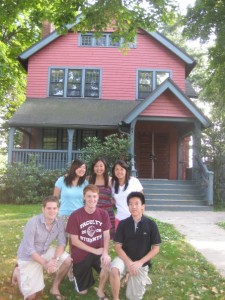Learn the campus and Important buildings
Andrew Roberts, author of The Thinking Students Guide to College: 75 Tips for Getting a Better Education, gives advice to college students looking to fully utilize all that their college has to offer. Roberts talks about choosing majors, interacting with professors, being successful and so on. What I believe that Roberts does not talk about is how to utilize the physical campus itself and its surroundings. Trinity College is located in the city of Hartford, Connecticut. Hartford is a very diverse city and gives opportunities to any Trinity student who wants to experience activities beyond this campus. It is an open campus which allows the local residents to enter on their own free will but this also allows the students to explore beyond the college campus. When I first arrived on campus I did not understand where anything was except my dorm and Mather hall. I am an out-of-state student and was unfamiliar with Connecticut. Due to my lack of familiarity, I did not take the initiative to learn about the campus and the surroundings and decided to learn only about the essential buildings: Mather Hall, Little Dorm, and Seabury.
I wish that I had utilized the campus more during my first semester at college. My advice would be to learn about the campus and its important buildings. There are many advantages to knowing your campus and important buildings in the campus. As you learn more about the campus you may find new interests that you may not have had before; many different buildings on campus are themed such as the social sciences, humanities, language, math, science buildings and much more. If you were to learn about them and the events they may offer they could provide unique learning opportunities find new interests, or even meet people that you would not have had the chance to meet. As a freshman you may not know what major or classes you want to take but if you were to just take a walk and enter a random building there is a variety of things you could find. Many buildings have bulletin boards that hold event posters or contacts for people with questions, comments and concerns. You can walk into almost any building to find and learn about what it’s used for and for what you could utilize it.
During my second week on campus I needed to find Trinity Commons. I went to the Welcome desk in Mather Hall and asked for a map, however, I am not very good at reading maps. I tried following the map and went to many buildings that were not Trinity Commons, but along the way I found many other buildings. I was forced to explore the campus so I could find Trinity Commons. Along the way I found the Ferris, which is where school dances, sports events and the gym are located. If I had not stumbled upon the building I may not have had the motivation to ever use it. I also found the buildings and grounds office. This is the building that you go to if you have any problems with your dorm. We had a broken blind and heating problems and when the time came to find buildings and grounds it was an easy trip. Knowing about the campus is very helpful for many reasons but one that many may overlook is the social aspect.
College is not only for academics but it is a very social experience. Knowing where buildings are on campus is very important when trying to attend events or looking for space to hold an event. Getting to know people at college could be one of the most important college experiences because not only will it help you during college, but it could help you after when trying to find a job. There are buildings that were built on campus that are geared to people’s specific interest. There are cultural houses such as, AASA (Asian Student Association), UMOJA (African American Student Association), and LVL (La Voz Latina, Latino Student Association). These houses are important because they hold events weekly; not only can you learn from these events but you may also be able to make connections with people that are similar to you or have similar interest. I am an African American student and have an interest in Asian studies. I decided to find the Asian American Student association house, AASA, and introduce myself. By the end of the meeting I did not know that I would be running for freshman correspondent, and no sooner become a member of their executive board. Taking chances, learning about the campus, and finding important buildings may be scary at first, but it may help you embark on an unexpected journey.

